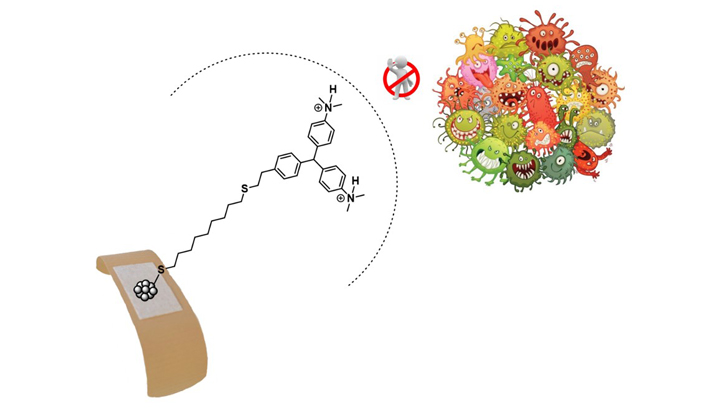Antibiotic protected silver nanoparticles for microbicidal textile materials

Antimicrobial materials have the ability to inhibit the growth of microorganisms such as bacteria, fungi, yeasts and algae. There is a high demand for microbicidal textile materials with applicability in several areas, such as, for example, in dental surgery equipment, in hospitals or in food packaging, among many others. The effectiveness of silver as an antibacterial agent has been known for centuries, but with the appearance of silver nanoparticles (AgNPs) its use is growing considerably. The smallest AgNPs have a greater surface-volume ratio and therefore they are very effective when interacting with microorganisms.
Taking advantage of our previous experience both in the field of the preparation of functional materials and in the synthesis of nanomaterials, we planned to synthesize ligands capable of stabilizing AgNPs that possessed in their structure an antibiotic moiety. The AgNPs surrounded by these antibiotic derivatives would be used in the surface coating of cotton fabrics in order to prepare potential microbicidal textiles.
We chose three antibiotics, all of them known for their bactericidal activity, Eugenol (Eug), Malachite Green (TAM) and fluoroquinolone (FQ). Eug and TAM were derivatized with a long hydrocarbon chain that possesses a terminal thiol (-SH), an appreciated functional group in the stabilization of metal NPs. In the case of FQ, and in order to prepare water-soluble AgNPs, its structure was modified through a covalent bond with a long polyoxyethylenated chain (PEG). Once the stabilizers were prepared, the synthesis of the AgNPs was performed (Figure 1). The used method was the same for the three antibiotics, the corresponding stabilizer was mixed with the silver precursor (silver nitrate) in a THF/water mixture under vigorous stirring. The reducing agent (NaBH4) was then added for the reduction of the Ag(I) cations to elemental Ag(0) The AgNPs were fully characterized.
Figura 1. AgNPs stabilized by TAM, Eug and FQ derivatives.
In order to prepare antimicrobial cotton fabrics, the AgNPs were dispersed on cotton fabrics and then their activity was analyzed against bacterial strains of Staphylococcus aureus and Pseudomonas aeruginosa. The microbicide experiments were carried out in collaboration with Prof. M. Llagostera and Dr. P. Cortés from the Department of Genetics and Microbiology of the UAB. In these studies, it has been shown that the microbicidal activity of the fabrics depends on the coating type of the AgNPs, the antibiotic used and its hydrophilicity. In the case of the fabric dispersed with Ag@TAM, an important decrease in the number of Staphylococcus aureus of 3 logarithmic units with respect to a target was observed. The coated fabric with Ag@FQ showed antimicrobial activity for the two strains tested, Staphylococcus aureus and Pseudomonas aeruginosa.
In summary, we have successfully modified antibiotics that have been employed as stabilizers for the preparation of Ag@NPs. Its dispersion on cotton fabrics has evidenced antimicrobial activity, especially in the cases of those impregnated with Ag@TAM and Ag@FQ, and therefore, they are materials with medical applications (i.e. plasters and bandages).
Department of Chemistry
Universitat Autònoma de Barcelona
References
Maria Montagut, Ana & Granados Toda, Albert & Ballesteros, Anna & Pleixats, Roser & Llagostera, Montserrat & Cortés, Pilar & María Sebastián, Rosa & Vallribera, Adelina. (2019). Antibiotic protected silver nanoparticles for microbicidal cotton. Tetrahedron. 75. DOI: 10.1016/j.tet.2018.11.035.

